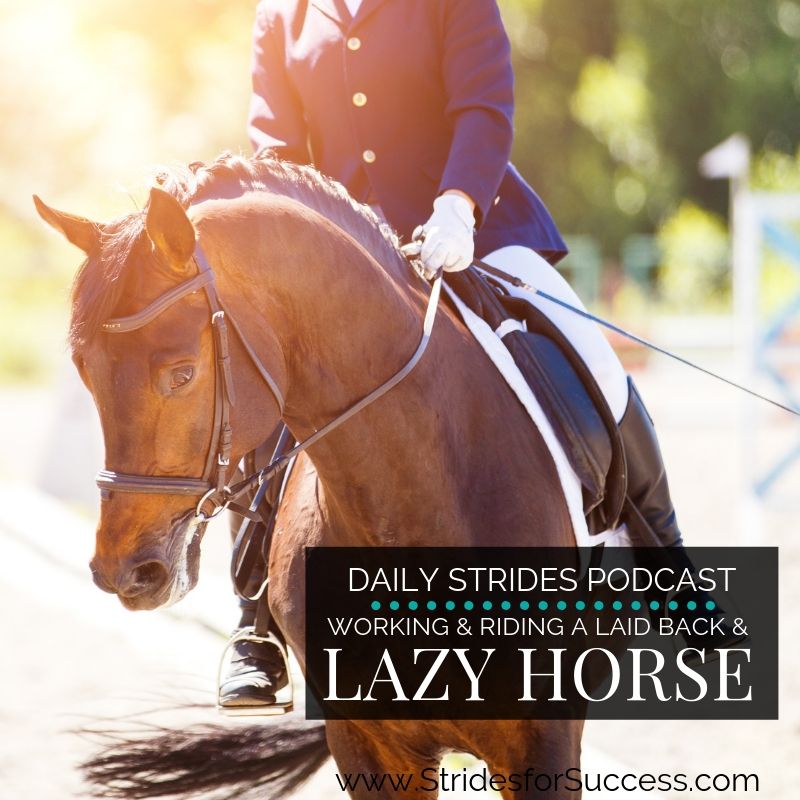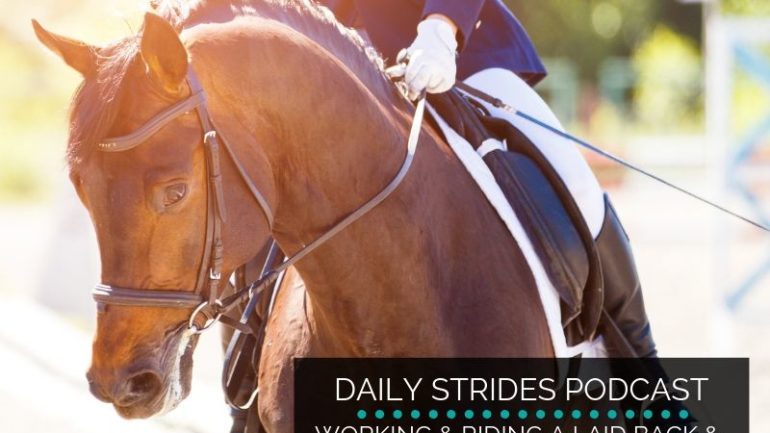
Some days does it feel like a mammoth task just to get your horse to put one foot in front of the other? He has no motivation whatsoever to do anything with any hint of enthusiasm or energy…
But first, I want to be clear; the term ‘lazy’ is not one that I enjoy using when it comes to horses. I believe that there are horses out there who are just more laid back than others. Lazy always sounds so derogatory. And often, those ‘lazy’ horses are actually wonderful trusty steeds.
We need all sorts of horses in the world to suit all sorts of riders…
However, if your horse is more laid back than most, I also understand how you may just want him to show a little more enthusiasm where his work is concerned.
Lazy or Unresponsive?
First, let’s look at the difference between a ‘lazy’ horse (yes, there is that word – again!) and an unresponsive horse. Often these two terms are used interchangeably. People feel that they are the same thing. I don’t agree. Yes, often there is a cross over, however, for the most part, they are different. Figuring out which your horse is is the first thing I would suggest you get clear on. The reason being that one can be ‘changed’ and one has to be worked with or around.
An unresponsive horse is, in my opinion, often created or trained that way due to rider error.
I have spoken a lot about this before HERE and the great news is that, with a lot of mindful riding, it can be undone. The simple truth of the matter is that your reactions or responses are always training your horse. For good or for bad. It is a good concept to keep in mind as you work with and ride your horse.
A laid back horse, on the other hand, is usually just that way inclined. His personality and temperament is such that he tends to naturally just take all situations as they come.
Once you are clear that your horse is indeed just a laid back soul, you can begin being mindful of how you can work ‘with’ him in each ride…
It All Starts with Your Position
I know, I know; it seems like a bit of a cheap tip – work on your position – but it is so important! Remember, if your horse’s natural inclination is to do as little as possible, he will look for ways to make that happen. He will look for ways out!
He will also, when feeling confused or conflicted, rather stop and wait than take action and hope it is the right action!
A good position will ensure that you are clear on what you are communicating in the first place. This is the first hurdle when it comes to motivating him to go forwards. There is a direct correlation between how frustrated a rider becomes and how well (or badly!) they ride.
Pay Attention to Lower Leg
In my experience, riders who are becoming a little frustrated with a lazy horse tend to have ‘wandering’ lower legs. Their lower leg can end up too far back. Almost close to the flank somewhere; okay that is a slight exaggeration, but you get the picture! Either way, if we snapped our fingers and made the horse vanish, the rider would land on their face!
The other extreme is the lower being too far forward; up at the horse’s elbow and shoulder.
This is often caused by the rider trying to push and shove the horse forward using their seat.
Whatever the reason, again, if we snapped our fingers and made the horse vanish, the rider would land on their bum!
The ‘Click Your Fingers Rule’ is always a good way to access how well your position is at any point in the ride.
Being in the Right Place Consistently
While being lazy (that word again!) and being unresponsive is different, if you are riding a ‘laid back’ horse you will have to up your game where responsiveness is concerned.
You have to first improve your riding and how you are showing up before your horse will improve his performance.
Showing up means being in the right place to ask the right questions. Having a solid position means that you will be clear when you apply your aids.
There is less chance of your horse becoming confused about what you are asking; or how he should respond to each question.
Be Prepared for the ‘Skip’
If you have ever ridden a lazy or laid back horse, you will know exactly what I am talking about here. Imagine that you are on your wonderfully chilled steed. By some miracle, you actually get him to move forward; to put more energy into his way of going.
Rather than transitioning smoothly from one gait to the next, he ‘skips’ or hops into the new gait. If there was a sound to describe it, it would ‘Hup’!
If you are not prepared for this ‘skip’ it can be very unbalancing. To the point where you end up falling backward and then stopping or blocking the forward energy.
The big issue when the rider becomes unbalanced is that the contact is often lost. Either the rider pulls on the reins in order to try and re-balance themselves. Or the rider throws the contact at the horse in an attempt to avoid catching him in the mouth.
Either way, as soon as the contact is lost, the forwardness is also lost. Which means returning back to square one.
Riding into Downward Transitions
The final key element of riding a lazy or laid back horse is being able to actually work through a downward transition. Horses who are inclined not to really go forward, to begin with, are surprisingly quick to change down gears!
Your job is, again, to remain balanced by having and maintaining a good position all the way through the transition. This good position will help you to keep your leg on, therefore keep the energy flowing,
Allowing your horse to fall into downward transitions will make the next gait also lack forwardness and energy.
Make sure you are setting each transition up correctly and then riding the horse through it. Ask bigger questions and expect more from him.
Shift Expectations & Have Patience
I really think that it all comes down to your position first and foremost. I also feel that as the ‘team leader’ you are all the time looking for new ways to keep your horse inspired.
Simple things like getting out of the arena and riding out with others are often enough to begin seeing the energy move.
Keep in mind that in order to move forwards, in the true sense of the word, your horse must engage his core. His core is going to take time to develop, so have patience and look for a few strides at a time initially.
Using natural slopes is a great way to help him get started. However, once again, you being in the right position is essential in order for you both to then capitalize on this.
Happy Riding
Lorna
Some other resources to help with this topic:-
- Applying the Click Your Fingers Rule to Your Position While Riding
- Increasing Your Horses General Responsiveness
- The Link Between Your Coordination and Your Horses Responsiveness
- Join the free Facebook group HERE
- The Daily Strides Podcast on iTunes
- Daily Strides Podcast on Google Play
- The Daily Strides Podcast on Stitcher Radio
- Join Daily Strides Premium
WHAT IS YOUR SEAT TELLING YOUR HORSE? FREEBIE
SUBSCRIBE TO GET THE PODCAST FREEBIE

